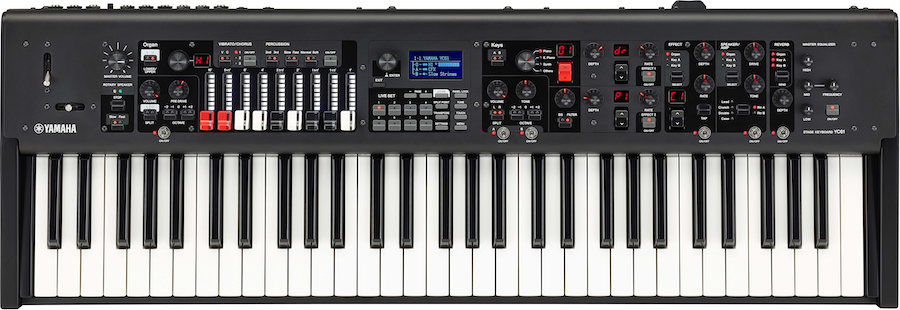Not to be out-done, Yamaha have announced the YC61 61-key Stage Keyboard. MSRP is $2,499 and MAP (Street) is $2,000.

The YC61 has waterfall keys and drawbars with VCM out the wazoo. The YC61 also includes FM synthesis for FM electric pianos. Speaking of pianos, the YC61 has acoustic pianos as well as electric:
- Acoustic pianos: CFX, S700, C7 and U1 upright.
- Electric pianos: Real FM, CP80, 78 Rhodes, 75 Rhodes Funky, 73 Rhodes, Wurlitzer.
The voice list in the Owner’s Manual shows:
- Acoustic pianos
- Electric pianos
- Synths (pad, strings, Brass, Lead, Bass, Chromatic Percussion)
- Strings
- Guitar
- Brass
- Sax/Winds
- Basses
- Chromatic Percussion (Glock, vibes, etc.)
- Accordions
The selection of voices is very rock, pop and jazz-oriented as one might expect in a keyboard of this type.
Tone generation technology is specified as: VCM Organ, AWM2, and FM. Looks like Yamaha has finally issued a modeled B-3. Polyphony specs are:
- VCM Organ + AWM2: 128
- FM: 128
There are 32 effect types including rotary speaker and amp sims, of course. The amp sims are British Combo, British Lead and Small Stereo, all of which are recent vintage. I can’t tell right now if the main rotary speaker effect is brand new or not.
Quoting the Owner’s Manual about the “VCM Organ tone generator:”
The VCM Organ tone generator was developed to faithfully reproduce the sound of a tonewheel-type vintage organ.
VCM stands for “Virtual Circuitry Modeling™,” and is technology that uses DSP to emulate the functions of an analog electric circuit. This technology enables the instrument to reproduce sound with an analog-like depth, which cannot be reproduced by a simple digital sound. By applying this technology, the VCM Organ tone generator fully reproduces the following characteristics of a vintage
Natural, organic harmonies when playing chords — thanks to a matrix circuit that connects the keyboard, tone wheels, and drawbars
Percussion sound with remarkable presence — based on vacuum tube circuit analysis
Key clicks and leakage sounds — based on electrical circuit analysis
Natural sound distortion — simulating vintage vacuum tube pre-amplifiers
Vibrato/Chorus effect — from scanner-based vibrato circuitry
Changes in frequency characteristics and drive amount that responds dynamically to operation of the expression pedal
Adjustment of these detailed parameters makes it possible to accurately recreate the distinctive characteristics of the original instruments — including all of their specially attractive imperfections, faults and even deterioration.
Organ models are H1 (standard vintage organ), H2 (mid- to low-emphasis), H3 (percussive), F1 (simple sine waves), F2 (Vox combo), F3 (Farfisa combo).
Dimensions are 35.25″ wide by 4.25″ high by 12.2″ deep. It weighs 15.6 pounds (7.1kg) which is quite reasonable!
I just downloaded the Owner’s Manual. It will take a little study to figure out how the effect units are allocated — the spec is not exactly clear by itself.
It looks like there is good MIDI control — lots of CCs. Naturally, the devil is in the details. One doesn’t always know what’s missing until you get down to the nitty gritty of voice and rig configuration. The YC61 has master keyboard functionality (four zones including organ).
Well, that’s enough to get you started. Download the manual. Then pop the popcorn, sit back and watch the usual Web mania.
Copyright © 2020 Paul J. Drongowski
